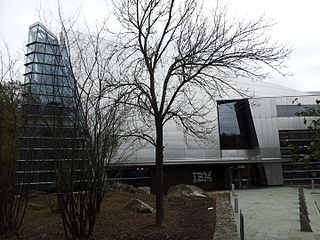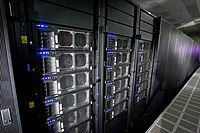Roadrunner components | |
| Active | Operational in 2008 Final completion in 2009 |
|---|---|
| Sponsors | IBM |
| Operators | National Nuclear Security Administration |
| Location | Los Alamos National Laboratory |
| Architecture | 12,960 IBM PowerXCell 8i CPUs, 6,480 AMD Opteron dual-core processors, InfiniBand |
| Power | 2.35 MW |
| Operating system | Red Hat Enterprise Linux |
| Space | 296 racks, 560 m2 (6,000 sq ft) |
| Memory | 103.6 TiB |
| Storage | 1,000,000 TiB |
| Speed | 1.042 petaFLOPS |
| Cost | US$100 million [1] |
| Ranking | TOP500 : 10, June 2011 |
| Purpose | Modeling the decay of the U.S. nuclear arsenal |
| Legacy | First TOP500 Linpack sustained 1.0 petaflops, May 25, 2008 |
| Web site | www |
Roadrunner was a supercomputer built by IBM for the Los Alamos National Laboratory in New Mexico, USA. The US$100-million Roadrunner was designed for a peak performance of 1.7 petaflops. It achieved 1.026 petaflops on May 25, 2008, to become the world's first TOP500 LINPACK sustained 1.0 petaflops system. [2] [3]

A supercomputer is a computer with a high level of performance compared to a general-purpose computer. The performance of a supercomputer is commonly measured in floating-point operations per second (FLOPS) instead of million instructions per second (MIPS). Since 2017, there are supercomputers which can perform up to nearly a hundred quadrillion FLOPS. Since November 2017, all of the world's fastest 500 supercomputers run Linux-based operating systems. Additional research is being conducted in China, the United States, the European Union, Taiwan and Japan to build even faster, more powerful and more technologically superior exascale supercomputers.

International Business Machines Corporation (IBM) is an American multinational information technology company headquartered in Armonk, New York, with operations in over 170 countries. The company began in 1911, founded in Endicott, New York, as the Computing-Tabulating-Recording Company (CTR) and was renamed "International Business Machines" in 1924.

Los Alamos National Laboratory is a United States Department of Energy national laboratory initially organized during World War II for the design of nuclear weapons as part of the Manhattan Project. It is located a short distance northwest of Santa Fe, New Mexico in the southwestern United States.
Contents
- Overview
- Hybrid design
- Development
- Phase 1
- Phase 2
- Phase 3
- Technical specifications
- Processors
- TriBlade
- Connected Unit (CU)
- Roadrunner cluster
- Shutdown
- See also
- References
- External links
In November 2008, it reached a top performance of 1.456 petaFLOPS, retaining its top spot in the TOP500 list. [4] It was also the fourth-most energy-efficient supercomputer in the world on the Supermicro Green500 list, with an operational rate of 444.94 megaflops per watt of power used. The hybrid Roadrunner design was then reused for several other energy efficient supercomputers. [5] Roadrunner was decommissioned by Los Alamos on March 31, 2013. [6] In its place, Los Alamos commissioned a supercomputer called Cielo, which was installed in 2010. Cielo was smaller and more energy efficient than Roadrunner, and cost $54 million. [6]

The TOP500 project ranks and details the 500 most powerful non-distributed computer systems in the world. The project was started in 1993 and publishes an updated list of the supercomputers twice a year. The first of these updates always coincides with the International Supercomputing Conference in June, and the second is presented at the ACM/IEEE Supercomputing Conference in November. The project aims to provide a reliable basis for tracking and detecting trends in high-performance computing and bases rankings on HPL, a portable implementation of the high-performance LINPACK benchmark written in Fortran for distributed-memory computers.
Cielo was a supercomputer located at Los Alamos National Laboratory in New Mexico, United States built by Cray Inc. From 31 March 2013, with the retirement of IBM Roadrunner, it took over as their front line computer.
















